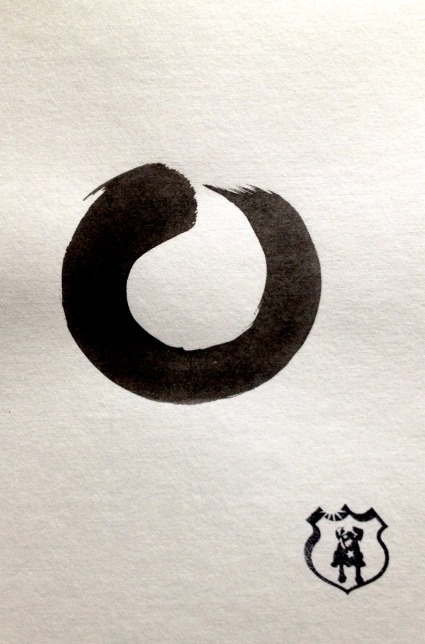 This post is Inspired by Robert Carter’s writing on Zen aesthetics ¹‚ ² specifically on enso sumi-e (ink painting) ³ and the energy of the brush.
This post is Inspired by Robert Carter’s writing on Zen aesthetics ¹‚ ² specifically on enso sumi-e (ink painting) ³ and the energy of the brush.
Oct 12
- Lesson from Sugi: Dogs are attuned to the moment and sensitive to energy from others.
- Sugi says, “I feel good when Julie is practicing art or mindfulness.”
Calligraphy and other Zen arts, such as landscape design, ceramics, tea-ceremony, and aikido are seen as a practice in self-culitivation; as forms of meditative practice towards cultivating a positive state of mind leading to compassion, benevolence and equanimity. One key aspect of Zen arts practice is that the mind become “unattached” so that the body can move freely with energy.
The image is a photo of a mark I created based on enso* (circle), a stroke traditionally made in sumi-e. I enacted an ‘enso’ session by meditating on mark making, with Sugi’s assistance of course. I made numerous marks trying out different relationships with energy, brush and mindfulness. The most successful marks had a represented energy, a balance of elements, and fluidity. I noticed that these ones were created when I did not think about controlling the brush, but instead focused on the energy needed.
I sent this one to my dear friend Sandra (who also designed the stamp image in the photo) as a birthday wish.
References
1. Carter, Robert. The Japanese Arts and Self Cultivation. Albany, NY: State University of New York Press, 2008.
2._____________. Becoming Bamboo: Western and Eastern Explorations of the Meaning of Life. Montreal & Kingston: McGill University Press, 1992.
3. from wikipedia: In Zen Buddhism, an ensō (円 相 ), “circle” is a circle that is hand-drawn in one or two uninhibited brushstrokes to express a moment when the mind is free to let the body create.The ensō symbolizes absolute enlightenment, strength, elegance, the universe, and mu (the void). It is characterised by a minimalism born of Japanese aesthetics. Drawing ensō is a disciplined practice of Japanese ink painting—sumi-e (墨絵)“ink painting” . The tools and mechanics of drawing the ensō are the same as those used in traditional Japanese calligraphy: One uses a brush to apply ink to washi (a thin Japanese paper). Usually a person draws the ensō in one fluid, expressive stroke. When drawn according to the sōsho (草書) style of Japanese calligraphy, the brushstroke is especially swift. Once the ensō is drawn, one does not change it. It evidences the character of its creator and the context of its creation in a brief, contiguous period of time.
